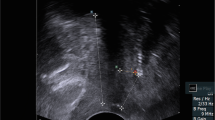Abstract
The aim of this study was to compare ultrasonographic findings on tape position, angulation and mobility following three surgical anti-incontinence procedures (trans-obturator tape (TOT), tension-free vaginal tape (TVT), tension-free vaginal tape obturator (TVT-O)) and to correlate these data with clinical signs of cures and failures and de novo voiding disorders. In this prospective study, vesicourethral static and dynamic analysis of 81 patients (30 TOT, 28 TVT, 23 TVT-O) were evaluated using introital ultrasonography. Width, position and appearance of the tape were similar in all three groups, i.e. like a “V” at rest, round angulation on Valsalva and closed angulation at maximum retaining. Moreover, closer angulation on Valsalva was associated with voiding disorders. Closer angulation at retaining was associated with de novo urge incontinence. Larger angulation of the tape at rest appeared to be significantly associated with recurrent stress incontinence. Ultrasonography could a be useful tool assessing anti-incontinence procedures and investigating post-operative voiding disorders.



Similar content being viewed by others
References
Nilson CG, Kuuva N, Falconer C, Rezapour M, Ulmsten U (2001) Long term results of the tension-free vaginal tape (TVT) procedure for surgical treatment of female stress urinary incontinence. Int Urogynecol J Suppl 2:5–8
Chene G, Amblard J, Tardieu AS, Escalona JR, Viallon A, Fatton B, Jacquetin B (2007) Long term results of Tension-free Vaginal Tape (TVT) for the treatment of female urinary stress incontinence. Eur J Obstet Gynecol Reprod Biol 134:87–94
De Lancey JO (1994) Structural support of the urethra as it relates to stress urinary incontinence: the hammock hypothesis. Am J Obst Gyn 170:1713–1723
Petros PE, Ulmsten UI (1993) An integral theory and its method for the diagnosis and management of female urinary incontinence. Scand J Urol Nephrol 153:1–93
Delorme E (2001) Transobturator urethral suspension: mini-invasive procedure in the treatment of stress urinary incontinence in women. Prog Urol 11:1306–1313
De Leval J (2003) Novel surgical technique for the treatment of female stress urinary incontinence: transobturator vaginal tape inside–out. Eur Urol 44(6):724–730
Lo TS, Horng SG, Liang CC, Lee SJ, Soong YK (2004) Ultrasound assessment of mid-urethra tape at three years follow-up after TVT procedure. Urology 63:671–675
Virtanen HS, Kiilhoma P (2002) Urogynecologic ultrasound is a useful aid in the assessment of female stress urinary incontinence: a prospective study with TVT procedure. Int Urogynecol J Pelvic Floor Dysfunct 13(4):218–222
Ducarme G, Rey D, Menard Y, Staerman F (2004) Transvaginal ultrasound and voiding disorders after TVT procedure. Gynecol Obstet Fertil 32:18–22
Amarenco G, Arnould B, Carita P, Haab F, Labat JJ, Richard F (2003) European psychometric validation of the CONTILIFE: a quality of life questionnaire for urinary incontinence. Eur Urol 43(3):391–404
Ingelman Sundberg A, Ulmsten U (1983) Surgical treatment of female stress urinary incontinence. Contrib Gynecol Obstet 10:51–56
Dargent D, Bretones S, George P, Mellier G (2002) Insertion of a sub-urethral sling through the obturating membrane for treatment of female urinary incontinence. Gynecol Obstet Fertil 30(7–8):576–582
Ulmsten U, Henricksson L, Johnson P, Varhos G (1996) An ambulatory surgical procedure under local anesthesia for treatment of female urinary incontinence. Int Urogynecol J 7:81–86
Cotte B, Dumousset E, Boda C, Mansoor A (2006) Comparison of transobturator tape and tension-free vaginal tape using perineal ultrasound. Gynecol Obstet Fertil 34:298–303
Haylen BT, Ashby D, Sutherst JR, Frazer MI, West CR (1989) Maximum and average urine flow rates in normal male and female populations—the Liverpool nomograms. Br J Urol 64(1):30–38
Massey JA, Abrams PH (1998) Obstructed voiding in the female. Br J Urol 61:36–39
De Tayrac R, Deffieux X, Resten A, Doumerc S, Jouffroy C, Fernandez H (2006) A transvaginal ultrasound study comparing transobturator tape and tension-free vaginal tape after surgical treatment of female stress urinary incontinence. Int Urogynecol J 17:466–471
Masata J, Martan A, Svabik K, Drahoradova P, Pavlikova M (2006) Ultrasound imaging of the lower urinary tract after successful tension-free vaginal tape (TVT) procedure. Ultrasound Obstet Gynecol 28:221–228
Schuettoff S, Beyersdorff D, Gauruder-Burmester A, Tunn R (2006) Visibility of the polypropylene tape after TVT procedure in women with stress urinary incontinence: comparison of introital ultrasound and magnetic resonance imaging in vitro and in vivo. Ultrasound Obstet Gynecol 27:687–692
Dietz H, Barry C, Lim Y, Rane A (2006) TVT vs Monarc: a comparative study. Int Urogynecol J 17:566–569
Dietz H (2004) Ultrasound imaging of the pelvic floor: part 1: 2D aspects. Ultrasound Obstet Gynecol 23:80–92
Dietz HP, Mouritsen L, Ellis G, Wilson PD (2004) How important is TVT location. Acta Obstet Gynecol Scand 83:904–908
Dietz HP, Wilson PD (2004) The « iris effect »: how 2-dimensional and 3-dimensional ultrasound can help us understand anti-incontinence procedures. Ultrasound Obstet Gynecol 23(3):267–271
Falconer C, Ekman Ordeberg G, Malmstrom A, Ulmsten U (1996) Clinical outcome and changes in connective tissue metabolism after intravaginal slingplasty in stress incontinent women. Int Urogynecol J Pelvic Floor Dysfunct 7(3):133–137
Author information
Authors and Affiliations
Corresponding author
Rights and permissions
About this article
Cite this article
Chene, G., Cotte, B., Tardieu, AS. et al. Clinical and ultrasonographic correlations following three surgical anti-incontinence procedures (TOT, TVT and TVT-O). Int Urogynecol J 19, 1125–1131 (2008). https://doi.org/10.1007/s00192-008-0593-z
Received:
Accepted:
Published:
Issue Date:
DOI: https://doi.org/10.1007/s00192-008-0593-z




